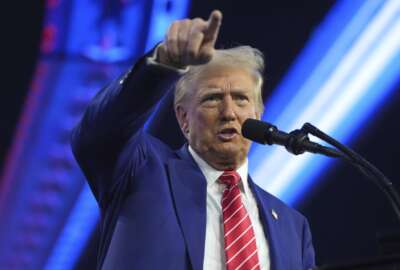GSA’s RFP for E-Travel system focuses on usability
Agency is taking lessons learned from the past seven years to make the new system more like commercial travel booking sites. Vendors have until Oct. 6 to submit...
wfedstaff | June 3, 2015 1:13 pm
By Jason Miller
Executive Editor
Federal News Radio
The General Services Administration is hopeful that the lessons learned in deploying online travel services across the government over the last seven years will make the next generation of systems closer to what employees use in their personal lives.
GSA, which issued a request for proposals for the E-Gov Travel System 2 (ETS2) Aug. 23, understands now more than ever that usability is the key to success.
“We identified many usability issues with ETS1 and many customer dissatisfaction areas that could be improved,” said Tim Burke, director of the Office of Travel and Transportation Services in the Federal Acquisition Service at GSA, in an interview with Federal News Radio.
One of those clearly is the travel planning side to bring the more consumer tools to the front end of the end-to-end applications. So that a traveler who needs to be empowered to make the best decision on behalf of the agency, to accomplish their mission and in the taxpayer’s interest, we can put out front to them a more consumer-like tool, but (it is) still government focused on the policy side. We are more than excited about it.
He added that his office has seen several demonstrations on technical capabilities in recent months that would “integrate many of these different tools that save time on the tool, allow the individual traveler and agencies to have better discretion on their point of choice whether it’s the right price or not or worth making the trip.”
GSA awarded Carson Wagonlit, EDS (now HP) and Northrop Grumman contracts to provide e-travel services for all civilian agencies in 2003. Since then 23 of 24 major agencies have implemented, or are implementing, one of the three systems. Burke said the Commerce and Justice departments are the two big outliers when it comes to E-Travel implementation. But both are making progress now. The Defense Department runs its own troubled e-travel system and is not a part of the E-Travel initiative.
Burke expects under the new RFP to move from three vendors to one or two.
“The RFP is fairly specific that we intend to further consolidate the market,” Burke said. “It is driven by a couple of factors. The voice of industry to invest in the government’s requirements-we still have specific requirements that does force industry to meet those in less than a fully commercial way. As we went to market the last few years, we identified that this is a volume driven business model. The government does 2-to-3 million transactions a year. So to have the best competition and to have the best cost factor industry must have that volume consolidated.”
Burke added that agencies spend between $10 billion and $12 billion a year on travel expenses such as airfare, hotels and rental cars.
The new deal would be a firm fixed price contract for 15 years: one three year contract with three four-year options. Burke didn’t say how much GSA estimates the new contract is worth. The previous deal was for 10 years and worth $450 million. Burke said it expires in 2013.
Burke said proposals are due Oct. 6, and GSA plans on evaluating bids this winter. Then in early 2011, he said GSA will downselect vendors and ask the remaining ones to provide a final and best offer as well as go through an independent verification and validation (IV&V) of their proposed system.
GSA then expects to make one or more awards in mid-to-late summer 2011.
Burke added that GSA expects to hold a bidders conference the week of Sept. 14. A date and place should be finalized in the next week or so.
Burke said there are several basic pillars for ETS2:
- Improved usability – That will come from a improved technology application, better business intelligence, better personalization and better navigation technologies.
- Optimized online travel planning – Burke said the goal is to model ETS2 after many of the commercial sites such as Orbitz or Travelocity.
- Sustainability – The new set of services will integrate with customer agency’s existing tools such as telepresence, Web conferencing and other collaboration applications. Burke said ETS2 will help employees make a decision whether to travel or conduct the meeting online.
Burke said ETS2 will not be a telepresence or technology buy. Instead it will let employees determine the best use of money in terms of traveling or holding a Web meeting.
“There are increased requirements to a degree, but most of it is specificity and clarification,” he said. “We really wanted to take the voice of the customer from ETS1and what we learned” and apply it to ETS2.
Burke said the e-travel initiative has made government travel better and cheaper.
He said before ETS1, agencies either used paper or a home-grown system to process travel authorizations, vouchers and expenses. Now, agencies are standardized around one of three systems, every agency is using an online system for at least some part of the travel process and 72 percent of all travel is booked via the Web. Previously, it was less than 5 percent.
“Not to say ETS was the perfect end-to-end solution by any means, we had some usability issues to start up, but the customers have migrated pretty effectively to it,” he said.
Another major improvement, he said, is e-travel data integrates with agency financial management systems.
“The integration to financial management systems in real time lets CFOs manage the auditing of this, and the disbursements and reimbursements in real time and on an auditable basis,” he said. “For some agencies at one time, it took 28-to-30 days to process a reimbursement. Now all reimbursements are done in 3-to-5 days.”
Burke estimates since 2004 the government has saved between $200 million and $250 million. GSA expects by 2013 for the savings to around $340 million. This is down from the $450 million in expected savings GSA estimated in 2003, but Burke said that’s because of slower than expected implementations.
“We are not buying a system or technology but at the core of the services is obviously technology and applications, most of this is online,” Burke said. “ETS2 is a streamlined, adaptable world-class travel management service that continually applies commercial best practices to realize travel efficiencies and deliver transparent, accountable and sustainable service that yields exceptional customer satisfaction.”
(Copyright 2010 by FederalNewsRadio.com. All Rights Reserved.)
Copyright © 2024 Federal News Network. All rights reserved. This website is not intended for users located within the European Economic Area.





